Author: Arthur Hayes, founder of BitMEX; Translator: Baishui, Golden Finance
The global elite has a variety of policy tools to maintain the status quo, which will cause pain now or later. I hold the cynical view that the only goal of elected and unelected bureaucrats is to remain in power. Therefore, the easy button is always pressed first. The hard choices and strong medicine are best left to the next administration.
It will take an extremely long series of articles to fully explain why the USD/JPY exchange rate is the most important global economic variable. This is my third attempt to describe the series of events that led us to the crypto Valhalla. If policymakers abandon the use of this tool, then I know that longer, harder, and more prolonged course-correcting actions will be taken. By then, I can provide you with a more comprehensive explanation of the sequence of monetary events and the relevant historical perspectives.
The real “oh, they are really screwed” moment came when I read two recent Solid Foundations newsletters written by Russell Napier about the lose-lose situation that monetary officials responsible for the peace between Japan and the United States have found themselves in. The latest newsletter, published on May 12, describes the simple buttons that the Bank of Japan (BOJ), the Federal Reserve (Fed), and the U.S. Treasury can use.
Quite simply, the Fed, acting on the orders of the Treasury, can legally exchange unlimited amounts of dollars with the BOJ for as long as they wish. The BOJ and the Ministry of Finance (MOF) can use these dollars to manipulate the exchange rate by buying yen. By appreciating the yen in this way, the following is avoided:
The BOJ raises interest rates and in the process forces regulated capital pools such as banks, insurance companies, and pension funds to buy Japanese Government Bonds (JGBs) at high prices and low yields. In order to buy these overpriced JGBs, these capital pools must sell their US Treasuries (UST) to raise dollars to buy yen and repatriate them.
The Treasury sells UST to raise dollars and buy yen.
If the largest holders of UST, Japanese companies, do not become forced sellers, it will help the US Treasury continue to finance the profligate federal government at negative real interest rates. Otherwise, the Treasury will have to initiate yield curve control (YCC). This is the ultimate destination, but it must be prevented for as long as possible due to the obvious inflationary and possible hyperinflationary effects.
BOJ rate hike = hara-kiri
Who is the largest holder of JGBs? The Bank of Japan.
Who is in charge of monetary policy in Japan? The Bank of Japan.
What happens to bonds when interest rates rise? Prices fall.
Who loses the most if interest rates rise? The Bank of Japan.
If the Bank of Japan raises interest rates, it will commit seppuku. Given its strong self-preservation instinct, the institution will not raise interest rates unless it has a solution to spread the losses to financial players other than itself.
If the Bank of Japan does not raise rates and the Fed does not cut rates, the dollar-yen interest rate differential will persist. Since the dollar yields more than the yen, investors will continue to sell the yen.
To understand why a weaker yen raises geopolitical and economic issues, let’s look at China.
China-Japan Game
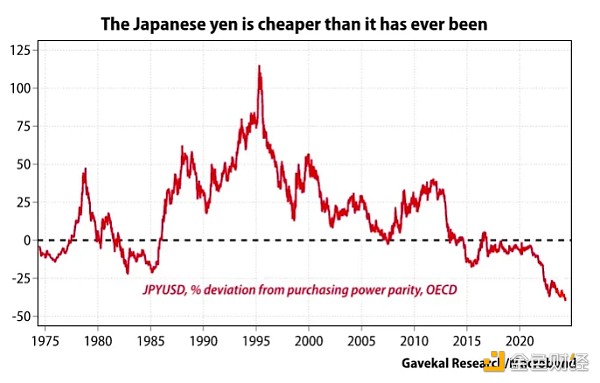
China and Japan are direct export competitors. The quality of Chinese goods in many industries is comparable to that of Japanese goods. Therefore, the only thing that matters is the price. If the RMB-JPY exchange rate rises (weaker yen and stronger RMB), China's export competitiveness will be damaged.
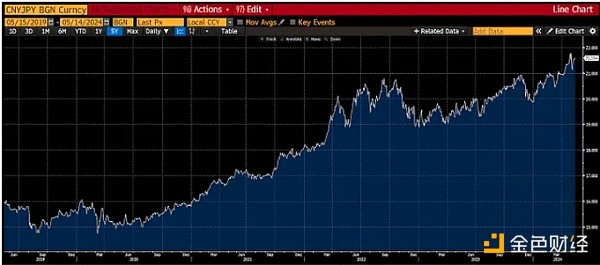
China is pinning its hopes of escaping deflation on manufacturing and exporting more goods.
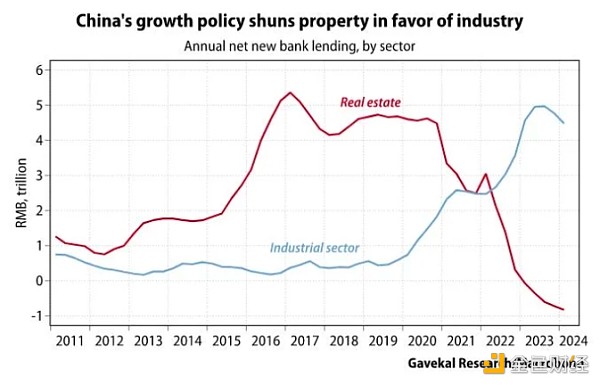
Wealth = bad
Manufacturing = good
This is where the cheap bank credit is flowing.
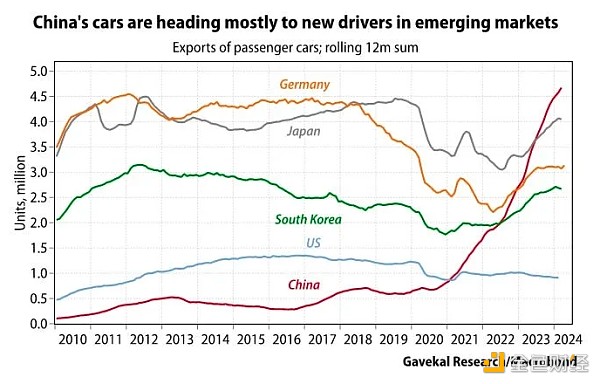
As you can see, China and Japan are neck and neck in the emerging passenger car export market. I use this as an example of global export competition. This is probably the most important export market given the number of cars purchased each year. In addition, the southern hemisphere is young and growing; they will increase the number of cars per capita in the coming years.
If the yen continues to weaken, China will respond by devaluing the yuan.
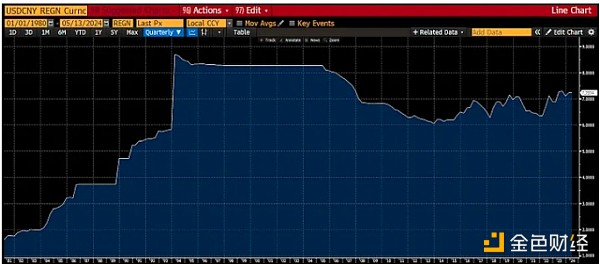
Since 1994, the People's Bank of China (PBOC) has essentially pegged the RMB to the dollar and allowed it to appreciate slightly. That's what this USDCNY chart shows. That's about to change.
China has to devalue the RMB implicitly by creating more onshore RMB credit, and explicitly by increasing the value of the RMB in USD, so that exports can outprice Japan. They have to do this to fight the deflationary depression caused by the bursting of the real estate bubble.
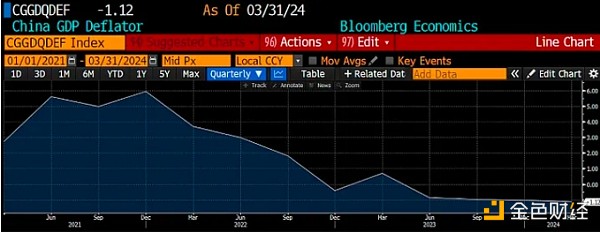
The GDP deflator converts nominal GDP into real GDP. A negative number means prices are falling, which is not a good thing for a debt-based economy. Since banks extend credit in exchange for asset collateral when asset prices fall, debt repayments are questioned and their prices fall. This is deadly, which is why China and other global economies need inflation to function.
It is easy to create the needed inflation; just print more money. However, China's printing press is not working hard enough. Credit is created, as always, by the commercial banking system.
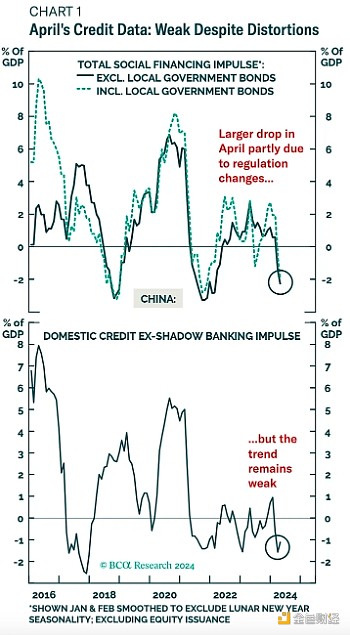
These BCA research charts clearly show a negative credit impulse, which indicates insufficient credit money creation.
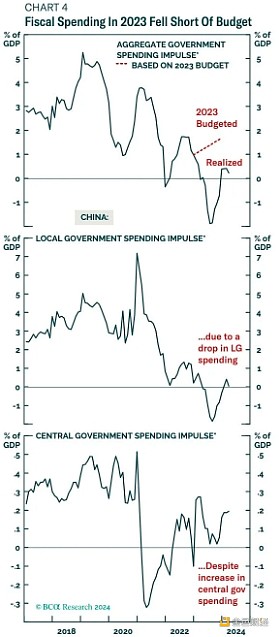
Local and central governments also did not invest enough money to end deflation.
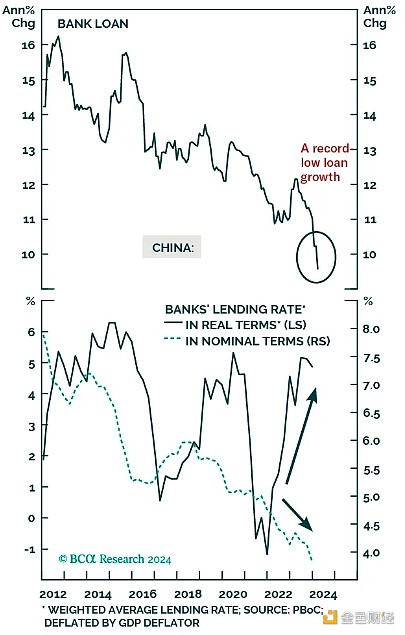
Real interest rates are positive. Growth in the quantity of money is falling, but its price is rising. Bad bad bad.
China has to create more credit, either through government spending or more loans to businesses. So far, China has not launched stimulus programs like it did in 2009 and 2015. I think this is because there are well-founded concerns that these domestic money creation policies will have a negative impact on the RMB, at least for now. Hopefully the RMB will remain stable against the dollar.
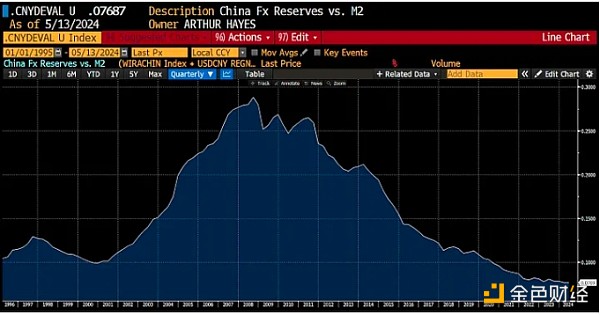
To make the above chart, I divided China’s M2 (RMB money supply) by reported FX reserves. At its peak in 2008, the RMB was 30% backed by FX reserves, which consisted mostly of UST and other USD assets. Currently, the RMB is backed by reserves at just 8%, the lowest level since the data was published.
If China ramps up credit creation, the money supply will grow further. This adds pressure on the RMB to keep its peg to the USD. I believe China wants to keep the USD/RMB exchange rate stable for both domestic and foreign political reasons.
Domestically, China does not want to exacerbate capital flight by devaluing the RMB significantly. In addition, it increases the cost of imports.
The key factor of concern for China is how Pax Americana will respond to a depreciating RMB. I will discuss this later, but a weak RMB makes Chinese-origin goods cheaper. This reduces the incentive for Americans to reshore their manufacturing capabilities. Why would they build expensive factories and hire expensive skilled labor (if they can find it) when their final products are still not price competitive with those made in China? Unless the US government hands out huge corporate welfare benefits, American manufacturing companies will continue to make their products abroad.
USA’s Declining Industrial States
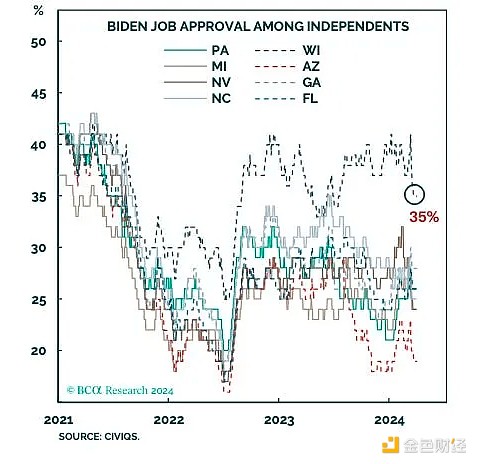
“Slow Joe” (Biden) is being crushed in states where manufacturing bases have moved to China over the past 30 years. If the Chinese yuan depreciates, jobs will continue to be lost. If Biden doesn’t win these states, he will lose the election. Trump’s 2016 victory was achieved by winning anti-China rhetoric in the declining industrial states of the United States.
Some readers may say that Biden’s staff has finally figured it out; the Biden administration’s anti-China rhetoric and actions are even more frequent. In fact, Biden just announced another increase in tariffs on a variety of Chinese-origin goods, including electric vehicles.
My point is that Chinese goods are not always shipped directly from China. If the product is cheap enough, China will export it first to countries friendly to the US, and then eventually to the US. The goods will be considered to be from another country, not China.
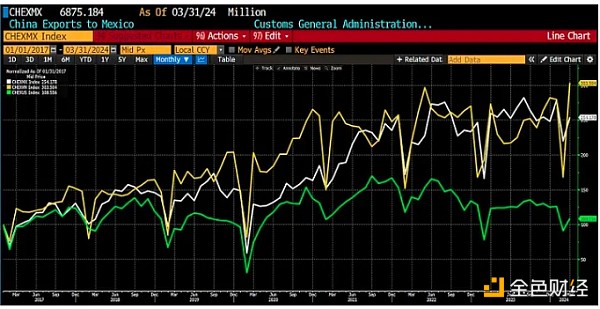
Here is a chart of Chinese exports to Mexico (white), Vietnam (yellow), and the US (green). Trump's rule began in 2017, the date the index started at 100. Trade between China and Mexico grew 154%, trade between China and Vietnam grew 203%, but trade with the US grew only 8%. Obviously, trade with the US is much higher than trade with Mexico and Vietnam, but China is clearly using these two countries as transit points for goods to evade tariffs.
If the goods are high quality and low priced, it will come to the US. While politicians will trumpet punitive tariffs to combat "dumping," China can easily change the destination of its exports. Countries like Vietnam and Mexico hope to earn a small commission by allowing goods to pass through their borders into the US.
Biden must win these battleground states to stop Trump. Biden cannot afford to devalue the yuan before the election. The Chinese will use this fear of losing the election to their advantage.
China's Response
If the US does not let Japan appreciate the yen, China will respond by devaluing the yuan against the dollar and exporting deflation to the world. Deflation is exported through mass production of cheap goods.
China is also pressuring Yellen to implement a weak dollar policy by increasing the global supply of dollars by any means necessary. This allows China to deploy economic stimulus again because the pace of RMB credit creation will match the pace of USD in relative terms.
In return, China will keep the USD/RMB exchange rate stable. The RMB will not depreciate against the USD. Perhaps China will even agree to limit the amount of products it exports to the US to help US companies reshore production.
If Yellen and Blinken refuse to accept this threat, I will take the nuclear currency option.
It is estimated that China has a stockpile of over 31,000 tons of gold. This is the government and private holdings combined. This gold is worth about $2.34 trillion at today's prices. The RMB is implicitly backed by 6% in gold. I divide the RMB money supply that China publishes by the value of all the gold that China holds.
I just mentioned that China's foreign exchange reserves as a percentage of M2 are 8%. The USD and gold back the RMB in roughly equal amounts.
The threat I think of is to announce a peg to gold. Here is how China could achieve this outcome:
Sell UST for gold as quickly as possible. At some point, the US may freeze Chinese assets or restrict China's ability to sell all of its approximately $1 trillion worth of UST. But I believe China will be able to quickly sell hundreds of billions of dollars worth of UST at fire-sale prices before US politicians start talking nonsense.
Instruct any state-owned enterprise that holds US stocks or UST to sell and buy gold.
Announce that the RMB will now be pegged to gold and its exchange rate will depreciate by 20% to 30% from current levels. The price of gold in RMB terms will rise (XAUCNY rises).
The Shanghai Futures Exchange (SFE) gold pricing is at a premium to the London Bullion Market Association (LBMA) pricing. This causes traders to arbitrage prices by taking long futures contracts to take delivery of gold in London and taking short futures contracts to take delivery of it in Shanghai. This draws gold from the West to the East.
As the global gold price rises, the value of physical gold in the warehouses of the London Bullion Market Association (LBMA) members falls, and one or more major Western financial institutions go bankrupt for lack of physical gold. There have long been rumors that Western financial institutions are nakedly shorting gold in the paper derivatives market. This would be GameStop on steroids, as it could cause the entire Western financial system to collapse due to the large amount of leverage embedded in the system.
The Federal Reserve is forced to print money to bail out the banking system, thereby increasing the supply of US dollars. This helps the RMB strengthen against the US dollar.
After reading these hypothetical scenarios, the reader may wonder why I believe that the United States can dictate Japan's monetary policy. The key assumption is that by threatening the United States, China can convince the United States to instruct Japan to appreciate the yen.
Japan often agreed to appreciation of the yen in the 1970s and 1980s to reduce the competitiveness of its exports relative to the United States and Western Europe (mainly Germany).
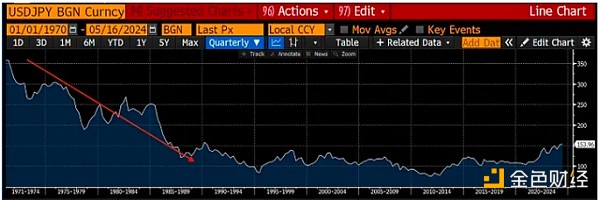
The above chart is the USD/JPY chart. At the beginning of the 1970s, the USD/JPY exchange rate was 350. Imagine how cheap Japanese goods were for Americans with inflation at that time.
Yellen is fully capable of politely suggesting that Japanese companies appreciate the yen this time to prevent retaliation from China.
If Japan plays ball, how will they play? Let me explain why Japan cannot make the yen stronger by instructing the Bank of Japan to raise interest rates and end quantitative easing.
Japanese Bond Math
I want to quickly explain why the BoJ will collapse faster than Sam Bankman-Fried on the witness stand if they raise rates.
The BoJ owns over 50% of all outstanding Japanese government bonds. They essentially price all bonds with a maturity of 10 years or less. What they really care about is the 10-year JGB rate, as that is the reference rate for many fixed income products (corporate loans, mortgages, etc.). Let's assume their entire portfolio consists of 10-year JGBs.
Right now, the 10-year JGB #374 in circulation is worth 98.682 and yields 0.954%. Assume the BoJ raises its policy rate to match the current UST 10-year yield of 4.48%. The JGB is now worth $70.951, a 28% drop (I’m using Bloomberg’s bond pricing function). Assuming the BoJ has 585.2 trillion yen worth of bonds and the USD/JPY exchange rate is 156, the mark-to-market losses are $1.05 trillion.
For the BoJ’s scam targeting yen holders, losing that much money is game over. The BoJ only holds $322.5 billion worth of equity. Even the crypto degenerates don’t trade with as much leverage as the BoJ. Seeing these losses, what would you do if you held yen or yen-denominated assets? Dump them or hedge them. Regardless, the USD/JPY is going to rise more than 200 times faster than Su Zhu and Kyle Davis escaped from the BVI court-appointed liquidator.
If the BoJ really must raise rates to narrow the USD/JPY differential, they will first force domestic regulated capital pools (banks, insurance companies and pension funds) to buy JGBs. To do this, these entities will sell their foreign currency denominated assets (primarily UST and US bonds), use these dollars to buy yen, and then buy high-priced JGBs with negative real yields from the BoJ.
From an accounting perspective, as long as these institutions hold to maturity, they do not have to mark to market their JGB portfolios and report large losses. However, their clients (the money they manage) will be financially oppressed and unable to bail out the BoJ.
From a Pax Americana perspective, this is a bad outcome, as the Japanese private sector will sell trillions of dollars worth of UST and US stocks.
Whatever Yellen proposes to strengthen the yen, it cannot require the Bank of Japan to raise rates.
Simple Button
As mentioned above, there is a way to weaken the dollar, reflate the Chinese economy, and appreciate the yen without selling any UST. I will discuss how unlimited USD/JPY currency swaps can solve this problem.
In order to weaken the dollar, its supply must increase. Imagine that Japan needs $1 trillion worth of firepower to strengthen the yen from 156 to 100 overnight. The Fed swaps $1 trillion for an equivalent amount of yen. The Fed prints dollars and the Bank of Japan prints yen. It costs the central banks nothing to do this because they have their own local currency printing presses.
These dollars exit the Bank of Japan's balance sheet because the Treasury must pay for yen in the open market. The Fed does not need yen, so the yen remains on the Fed's balance sheet. When a currency is created but remains on the central bank's balance sheet, it has been sterilized. The Fed sterilized the yen, but the Bank of Japan released $1 trillion into global money markets. Therefore, as the supply increases, the dollar weakens against all other currencies.
With a weaker dollar, China can create more onshore RMB credit to counter the harmful effects of deflation. If China wants to keep the USD/CNY exchange rate unchanged at 7.22, it can create an additional RMB 7.22 trillion ($1 trillion * 7.22 USD RMB) of domestic credit.
The RMB/JPY exchange rate falls, which is a weakening from the Chinese perspective and a strengthening from the Japanese perspective. The global supply of RMB increases, while the amount of yen decreases because the Japanese Ministry of Finance buys yen with dollars. Right now, the yen is fairly valued relative to the yuan based on purchasing power parity.
Any asset that is dollar-based will go up in price. This is good for the U.S. stock market and ultimately the U.S. government, since it imposes capital gains taxes on profits. It’s good for Japanese companies, since they collectively own more than $3 trillion worth of dollar assets. Cryptocurrencies are booming as liquidity in the system increases.
Domestic inflation in Japan falls as the cost of imported energy falls due to the strength of the yen. However, exports will suffer due to the strength of the currency.
People get something, some more than others, but this helps keep the global dollar system intact ahead of the U.S. presidential election. No country has to make painful choices that negatively impact its domestic political standing.
To understand the risks to the US of engaging in such behavior, first, I need to equate YCC with this USD/JPY swap silliness.
Same, but different
What is YCC?
It refers to the willingness of a central bank to print unlimited amounts of money to buy bonds in order to fix prices and yields at politically favorable levels. Because of YCC, the money supply increases, causing the currency to depreciate.
What is the USD/JPY swap arrangement?
The Fed is ready to print unlimited dollars so that the BoJ can prevent rate hikes, thus causing UST to sell off.
The result of both policies is the same; that is, UST yields less than it would otherwise. Moreover, as supply increases, the dollar will weaken.
The swap line is politically better because it happens in the shadows. Most commoners and even nobles do not understand how these instruments work or where they are hidden on the Fed's balance sheet. It also does not require consultation with the US Congress because the Fed was given these powers decades ago.
YCC is much more visible and is sure to cause strong concerns among engaged and angry citizens.
Risks
The risk is that the dollar depreciates too much. Once the market equates the USD/JPY swap line with the YCC, then the dollar will sink to the bottom. When the swaps are finally unwound (which they will eventually), it will mean the end of the dollar reserve system.
Given that it will take many years for the market to force this easing, the politicians who are worried today will support expanding the USDJPY swap lines.
Things to Watch
Keep an eye on the USDJPY exchange rate, not the Solana developers monitoring uptime. In fact, closer…
The USDJPY spread issue has not been resolved. Therefore, the yen will continue to weaken regardless of intervention. After each intervention, open this webpage and monitor the size of the USDJPY swap lines. On Bloomberg, monitor the FESLTOTL index. If it starts to increase significantly, and I mean billions of dollars, then you know this is the path the elites have chosen.
At this point, add the size of the USD swap lines to your handy USD liquidity index. Sit back and watch crypto rise against fiat currencies.
Two Possible Mistakes
I could be wrong on two counts.
The Bank of Japan is changing its weak yen policy with a big rate hike, and says it will continue to raise rates. By "substantially" I mean 2% or more. A mere 0.25% rate hike will not erode the 5.4% interest rate differential between the dollar and the yen.
The yen continues to weaken, and the United States and Japan are powerless to stop it. China retaliates by devaluing the yuan against the dollar or pegging it to gold.
If either of these scenarios occurs, it will eventually give way to a US YCC in some form, but the path to that is complicated. I have a theory about the sequence of events that will get us from here to there, and if necessary I will publish a series of posts on the subject.
Timing is Everything
The market knows the yen is too weak. I believe the pace of yen depreciation will accelerate heading into the fall. This will force the US, Japan and China to act. The US election is a big driver for the Biden administration to come up with a solution.
I think a surge to 200 USD/JPY would be enough for the Chemical Brothers to "push the button".
This is why all crypto traders must constantly monitor the USD/JPY. I believe the clown brigade responsible for Pax Americana will take the easy way out. It just makes political sense.
If my theory comes to fruition, it would be a piece of cake for any institutional investor to buy a US-listed Bitcoin ETF. Bitcoin is the best performing asset in the face of global fiat currency depreciation,and they know it too. When a move is made in response to yen weakness, I will mathematically predict how inflows into the Bitcoin complex will push the price to $1 million and possibly higher.
 JinseFinance
JinseFinance

















